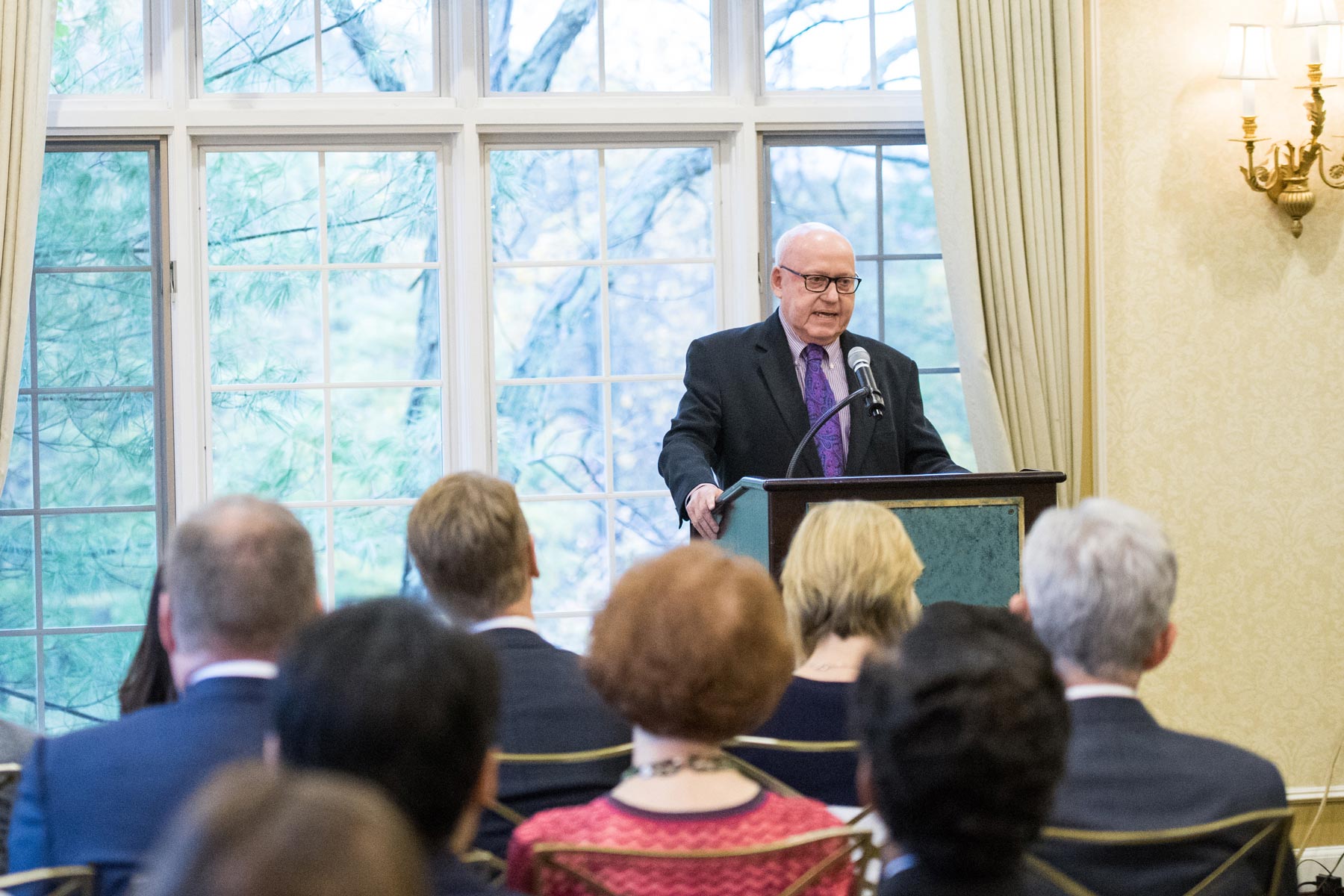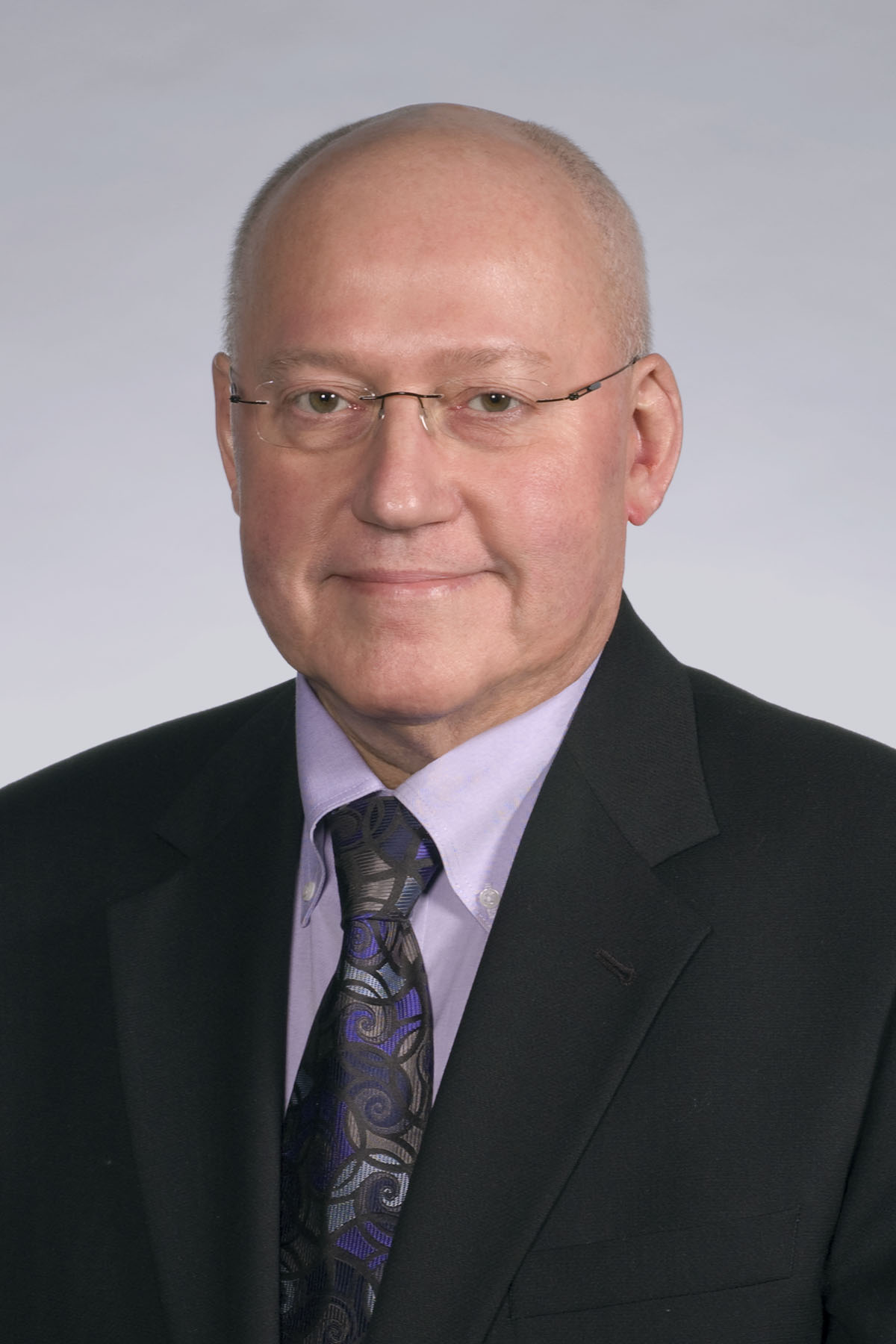Remarkable Career Yields Long-term Benefits for Dermatology
John J. Voorhees, MD, DF 2023 Distinguished Service Medallion
December 2023


John J. Voorhees, MD, FRCP (London), recipient of the 2023 DF Distinguished Service Medallion
In every field of medical science, there are a handful of leaders recognized by their peers as giants. Dr. John Voorhees, MD, FRCP (London), is one such leader. In an illustrious career spanning several decades, Dr. Voorhees has advanced medical knowledge through dermatologic research, developed innovative approaches to psoriasis treatment, taught and mentored dozens of dermatologists, chaired the University of Michigan Department of Dermatology, and played a fundamental part in defining the Dermatology Foundation’s role as a fundraising organization that awards research grants.
In recognition of his exemplary career, Dr. Voorhees received the 2023 DF Distinguished Service Medallion at the AAD 2023 Annual Meeting. He is one of only seven dermatologists in the Foundation’s 60-year history to receive this honor.
Biographical sketch
Dr. Voorhees graduated from the University of Michigan Medical School in 1963 and has remained in Ann Arbor ever since. Following internship, he spent two years serving at a US Army hospital in France as Officer in Charge of Internal Medicine and hospital laboratories. After returning to Ann Arbor, he completed his residency, starting in Internal Medicine before switching to Dermatology.
“I liked dermatology in medical school because we could make a definitive diagnosis from a biopsy,” he said.
For research, it also meant he could obtain samples of normal and diseased skin for study in the lab, which is what he began doing as a postdoctoral fellow. Dr. Voorhees entered the lab wanting answers to questions that didn’t yet exist. He spent 10 years in research before becoming department chair, a position he held for 43 years.
Despite receiving multiple offers from other universities, Dr. Voorhees has shown the value of digging deep at one institution. He has attracted millions of dollars in research grants and other funding for dermatology research at the University of Michigan and has brought talented researchers on board, helping them to establish both their labs and their academic careers.
Growing a vibrant department
Dr. Voorhees served as Chair of the University of Michigan Department of Dermatology from 1975 to 2018. Starting from a team of three, he developed one of the largest academic dermatology departments in the United States, with many researchers and clinicians leading seven distinct research groups and three clinical divisions. “I built the department to be one of the best in the world,” he said. “That’s what I’m most proud of.”
Mentorship and teaching
Following residency, Dr. Voorhees began teaching and hasn’t stopped since. He has mentored more than 75 world-class dermatologists, over 20 of whom have gone on to be department chairs.
After his postdoctoral fellowship, he headed the department’s sole research lab. Largely through his efforts, there are now several research labs studying skin biology and cancer, sebaceous gland biology, skin aging, psoriasis genetics, skin autoimmunity, and cutaneous bioinformatics.
A pillar of the Dermatology Foundation
Dr. Voorhees held various leadership positions during his 40 years with the Foundation. After his service as Chair of the Board (1983–1987) and then President (1987–1988), he remained an active member of the Executive Committee for another 30 years.
Eight years into his term as Chair at Michigan, Dr. Voorhees received a call from Dr. Tom Fitzpatrick, who then was the departmental chair at Harvard University and one of the founders of the Dermatology Foundation, asking him to take over running the Foundation.
Soon after becoming the new Chair, Dr. Voorhees realized the need to raise the Foundation’s profile as a fundraising organization for dermatology research. He persuaded a handful of corporations to make unrestricted donations.
He then inaugurated a campaign to solicit significant personal donations from dermatologists, further bolstering the Foundation’s abilities to support research projects.
“Modern academic medicine is so complicated that everyone needs careful mentorship. I wouldn’t have been able to mentor so many people over the decades without the grants we received from several organizations.”
Dr. Voorhees also played a major role in establishing the Foundation’s annual Clinical Symposium, which brings together current-day experts to present the latest CME information.
Discovering psoriasis as an immune disease
Dr. Voorhees’ research helped determine that psoriasis results from an overactive immune system. When he began work in this field, researchers believed psoriasis was the consequence of the high rate of epidermal cell turnover caused by dysregulated cell cycle.
Most research focused on inhibiting high turnover with drugs such as methotrexate. His lab focused on the molecular basis of this high turnover, looking for ways to elevate cycle AMP (cAMP) levels, since these were reduced in psoriatic lesions.
The role of prostaglandins in psoriasis was becoming evident. Dr. Voorhees knew prostaglandins in the skin were important regulators of cAMP formation and spent several years identifying those that elevated cAMP levels. During this time, a publication showed cyclosporine inhibiting eicosanoids and derivative prostaglandins, which piqued his interest. Cyclosporine is an immunosuppressant, inhibiting prostaglandins, and was used to prevent rejection of kidney transplants.
Dr. Voorhees followed his hunch that cyclosporine would work to treat psoriasis and, in 1986, he and his colleagues published a double-blind study showing that cyclosporine improved psoriasis symptoms in almost all patients treated (Ellis et al. 1986). This study suggested that psoriasis might have an immunologic basis and provided a significant advance in disease treatment. Moreover, cyclosporine supplied a critical tool for translational research investigating the signaling pathways involved in psoriasis.
Retinoic acid and aging of skin
Another serendipitous cross-pollination led Dr. Voorhees to study skin aging, a subject he knew little about at the time. He attended a presentation describing research investigating the role of retinoic acid in acne treatment, which noted clinical improvement in wrinkling in some patients.
Certain women in the study had a red rash and chapped lips from the treatment, which Dr. Voorhees had also seen in his work with a second-generation retinoic acid, known as etretinate, that he used to treat psoriasis. His familiarity with retinoids allowed him to quickly realize the possible connection between topical retinoids and anti-wrinkling.
After securing a grant from the company that made topical retinoic acid, tretinoin, he published results of a double-blinded study showing topical tretinoin improved photoaging in skin (Weiss et al. 1988). This led him to co-author many papers outlining the function of retinoic acid in aging skin.
Role of collagen degradation
Further research completed at Michigan with Dr. Gary Fisher and others, showed how time and UV light destroy collagen support in the skin, and identified the molecular pathways for aging and sun-induced premature aging of skin.
“Other than various retinoids, we weren’t able to predict other classes of drugs that might treat aging skin,” he said. “So, we conducted basic research, which led to discoveries about the role of collagen and collagen breakdown in skin aging.”
They found that collagen in aged skin—in both natural aging and photoaging—is broken down and can’t properly attach to fibroblasts. This leads to a cascade of effects: the fibroblasts collapse, then release increased amounts of collagenase (MMP-1), perpetuating further breakdown.
Simultaneously, collagen synthesis decreases because reactive oxygen, which increases during natural aging as well as with UV exposure, down-regulates TGF-𝛃 II receptors and the TGF-𝛃 Smad pathway (Quan et al. 2014; Qin et al. 2018). The breakdown of collagen and decreased production of collagen become a self-perpetuating process. He saw that, to treat aging skin, this cycle had to be broken.
The cycle can be improved by topical retinoic acid, which leads to the release of chemokines and an increase in collagen formation (Pedersen et al. 2019). Collagen can take a few months to form, but once it’s produced it has a half-life of 15 years. The surfeit of over-the-counter creams and lotions containing retinol are effective because the skin converts retinol to retinoic acid.
Dr. Voorhees and his group (Drs. Gary Fisher and Frank Wang) also found that injecting cross-linked hyaluronic acid helped rejuvenate aged skin where it acts, not only as a filler, but by reforming collapsed fibroblasts (Cui et al. 2021). Previous work in the lab had shown that reshaping the fibroblasts would decrease the amount of collagenase produced and increase collagen production.
Current research
Dr. Voorhees continues to be committed to his work in photoaging, and in addition, has been furthering research into the molecular genetics of psoriasis, along with Dr. James T. Elder, a colleague he has been working with for 30 years.
This work has identified many psoriasis association signals that contribute to the formation of psoriasis.
Other recent work includes using transgenic mouse models that overexpress MMP-1 to study aging and skin cancer. Along with principal investigators, Drs. Andrzej Dlugosz and Gary Fisher, they have found that transgenic mice are more likely to develop squamous cell papillomas, independent of UV damage. Some of these lesions undergo further neoplastic progression to become squamous cell carcinoma.
Dr. Voorhees’ vision and diligence have greatly influenced the evolution of modern dermatology and the education of the next generation of physicians and medical scientists.
Select offices held
- President, Michigan Dermatological Society (1983–1984)
- President, Dermatology Foundation (1987–1988)
- President, Association of Professors of Dermatology (1991–1992)
- President, Society for Investigative Dermatology (1996–1997)
- President, American Dermatological Association (2008–2009)
- Elected an AAAS Fellow for contributions to dermatology (2022)
Select awards
- Taub International Memorial Award for Research in Psoriasis (1973 and 1986)
- Lifetime Achievement Award of the National Psoriasis Foundation (1993)
- Arthur Rook Oration: Photoaging and Aging: Mechanisms and Therapy. 84th Annual Meeting of the British Association of Dermatology (2004)
- Stephen Rothman Memorial Award of the Society for Investigative Dermatology (2005)
- Michigan Institute for Clinical and Health Research (MICHR) Distinguished Clinical and Translational Research Mentor Award (2020)
- EADV International Award bestowed at the academy’s Berlin EADV Congress Meeting in recognition of significant accomplishments (2023)
Publications
With more than 700 publications, Dr. Voorhees is one of the top few, most-cited dermatologists in the world. His professional biography provides a more complete list of his numerous awards, memberships, and accolades.
References
Cui Y, Wang F, Voorhees JJ, et al. Rejuvenation of aged human skin by injection of cross-linked hyaluronic acid. Plast Reconstr Surg. 2021;147(1S-2):43S–49S.Ellis CN, Gorsulowsky DC, Hamilton TA, et al. Cyclosporine A improves psoriasis in a double-blind study. JAMA. 1986;256:3110–3116.
Pedersen, ES, Voorhees JJ, Sachs, DL. Topical Retinoids for the Treatment of Photoaged Skin. In: Griffiths CEM and Watson REB, ed. Cutaneous Photoaging. London, UK: Royal Society of Chemistry; 2019:341–362.
Qin Z, Fisher GJ, Voorhees JJ, et al. Actin Cytoskeleton Assembly Regulates Collagen Production via TGF-β Type II Receptor in Human Skin Fibroblasts. J Cell Mol Med. 2018;22:4085–4096.
Quan T, He T, Kang S, Voorhees JJ, et al. Solar ultraviolet irradiation reduces collagen in photoaged human skin by blocking transforming growth factor-beta type II receptor/Smad signaling. Am J Pathol. 2004;165(3):741–751.
Weiss JS, Ellis CN, Headington JT, et al. Topical tretinoin improves photoaged skin: A double-blind vehicle-controlled study. JAMA. 1988;259:527–532.

